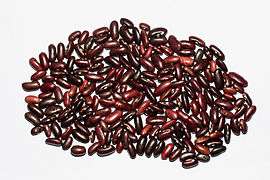Kidney bean
The kidney bean is a variety of the common bean (Phaseolus vulgaris). It is named for its visual resemblance in shape and – for the red variety – colour to a human kidney. Red kidney beans should not be confused with other red beans, such as adzuki beans.
| Nutritional value per 100 g (3.5 oz) | |
|---|---|
| Energy | 532 kJ (127 kcal) |
22.8 g | |
| Sugars | 0.3 g |
| Dietary fiber | 7.4 g |
0.50 g | |
8.7 g | |
| Vitamins | Quantity %DV† |
| Thiamine (B1) | 14% 0.16 mg |
| Riboflavin (B2) | 5% 0.06 mg |
| Niacin (B3) | 4% 0.58 mg |
| Pantothenic acid (B5) | 4% 0.22 mg |
| Vitamin B6 | 9% 0.12 mg |
| Folate (B9) | 33% 130 μg |
| Vitamin C | 1% 1.2 mg |
| Vitamin E | 0% 0.03 mg |
| Vitamin K | 8% 8.4 μg |
| Minerals | Quantity %DV† |
| Calcium | 3% 28 mg |
| Copper | 12% 0.24 mg |
| Iron | 22% 2.9 mg |
| Magnesium | 13% 45 mg |
| Phosphorus | 20% 142 mg |
| Potassium | 9% 403 mg |
| Sodium | 0% 2 mg |
| Zinc | 11% 1.07 mg |
| Other constituents | Quantity |
| Water | 67 g |
| |
| †Percentages are roughly approximated using US recommendations for adults. Source: USDA Nutrient Database | |

Classification
There are different classifications of kidney beans, such as:
- Red kidney bean (also known as: common kidney bean, rajma in India, surkh (red) lobia in Pakistan).
- Light speckled kidney bean (and long shape light speckled kidney bean).
- Red speckled kidney bean (and long shape light speckled kidney bean).
- White kidney bean (also known as cannellini in Italy, lobia in India, or safaid (white) lobia in Pakistan).
Nutrition
Kidney beans cooked by boiling are 67% water, 23% carbohydrates, 9% protein, and contain negligible fat (table). In a 100 gram reference amount, cooked kidney beans provide 530 kJ (127 kcal), and are a rich source (20% or more of the Daily Value, DV) of protein, folate (33% DV), iron (22% DV), and phosphorus (20% DV), with moderate amounts (10-19% DV) of thiamin, copper, magnesium, and zinc (11-14% DV).
Dishes
.jpg)
Red kidney beans are commonly used in chili con carne and are used in the cuisine of India, where the beans are known as rajma. Red kidney beans are used in southern Louisiana for the classic Monday Creole dish of red beans and rice. The smaller, darker red beans are also used, particularly in Louisiana families with a recent Caribbean heritage. Small kidney beans used in La Rioja, Spain, are called caparrones. In the Netherlands and Indonesia, kidney beans are usually served as soup called brenebon.[1] In the Levant a common dish consisting of kidney bean stew usually served with rice is known as fasoulia. To make bean paste, kidney beans are generally prepared from dried beans and boiling until they are soft, at which point the dark red beans are pulverized into a dry paste.
Toxicity
Red kidney beans contain relatively high amounts of phytohemagglutinin, and thus are more toxic than most other bean varieties if not pre-soaked and subsequently heated to the boiling point for at least 10 minutes. The US Food and Drug Administration recommends boiling for 30 minutes to ensure they reach a sufficient temperature long enough to completely destroy the toxin.[2] Cooking at the lower temperature of 80 °C (176 °F), such as in a slow cooker, can increase this danger and raise the toxin concentration up to fivefold.[3] Canned red kidney beans, though, are safe to use immediately, as they are cooked prior to being shipped. As few as 5 raw beans or a single undercooked kidney bean can cause severe nausea, diarrhea, vomiting, and abdominal pains.[4][5][6]
References
- "Recipe: Soup Brenebon". FAO.
- "Bad Bug Book (2012)" (pdf). Foodborne Pathogenic Microorganisms and Natural Toxins Handbook: Phytohaemagglutinin. Food and Drug Administration. 2012. Retrieved 26 December 2013.
Consumers should boil the beans for at least 30 minutes to ensure that the product reaches sufficient temperature
- Phytohaemagglutinin. Foodborne Pathogenic Microorganisms and Natural Toxins Handbook, US Food and Drug Administration (2009)
- "Be Careful With Red Kidney Beans in The Slow Cooker". Mother Earth News.
- "Cooking safely with slow cookers and crock pots". foodsmart.govt.nz. Archived from the original on 2016-01-02. Retrieved 2015-03-06.
- "Raw Kidney Beans". Home Food Preservation (Penn State Extension).